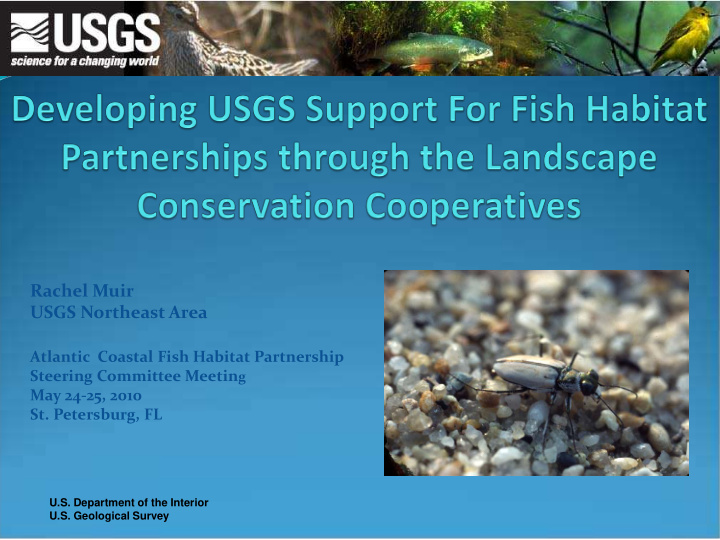



Rachel Muir USGS Northeast Area Atlantic Coastal Fish Habitat Partnership Steering Committee Meetin g May 24-25, 2010 St. Petersburg, FL U.S. Department of the Interior U.S. Geological Survey
Habitat is for everyone -- Northeastern Beach Tiger Beetle (threatened status under ESA) -- Beach habitat – good for fish too!
Status and Update USGS Support to the Landscape Conservation Cooperatives (LCCs) North Atlantic LCC (initiated 2010 – lead -- USFWS) South Atlantic LCC (initiated 2010 – lead – USFWS) Appalachian LCC (initiated 2011 – lead – USFWS planning stage DOI Regional Climate Change Science Centers – (RCCSC) -- Status USGS Re-Organization & Fish Habitat Partnerships
USGS Support to LCCs 2010 Budget has $5 million to support LCCs; For the 8 LCCs to be put in place in 2010, USGS is providing 2 RGE level scientists to support each; Funds have been allocated to Leetown Science Center for North Atlantic LCC; to Patuxent Wildlife Research Center for South Atlantic; Remaining funds to an internal USGS competitive grant process; pre-proposals accepted in 2/10.
How will USGS Support LCCs? USGS Commitments to USGS Benefits from LCC LCCs: Partnership Respond to Partner Needs Direct and Strengthen science capacity Research & Modeling Builds traditional strengths Adaptive Response Partners with other Forecasts Expertise Develop Monitoring Leverages Resources Protocols Multi-Disciplinary
DOI Climate Science Centers • University Based Competitive Process • 3+ RCCRC Funded in FY 2010 • Program Announcement in May • 2010 -- • Staffing – Director/Coordinator, Ecologists, DOI Climate Science Centers Modelers, Climate Scientists, Cooperators: DOI Science Science & Resource Population Biologists (?), Staff Management Hydrologists (?), Sociologists (?)
NCCWSC APPROACH DOI Use GCM’s Downscaling & CSC’s Develop Ecosystem Response Derivatives & Forecasting Regional Habitat & Population Response Forecasting LCC’s Habitat & Species Response Food Habitat Recruitment Adaptive Management & Monitoring Site Specific Species or Populations Response
USGS Regional Organization
Conservation Challenge Forecasting potential effects of climate change on fish, wildlife, and their habitat to inform management and conservation actions For most species of fish and wildlife, little is known about effects of climate change: • Physiological ranges • Impacts on character and distribution of habitats • Changes in distribution, abundance and survival
Organization and Fish Habitat Partnerships Liaison primarily with Objectives: Region and Regional Connect with full range Science Officers of USGS capabilities ACFHP – Rachel Muir Increase direct (Northeast) involvement of agency scientists SARP – Sonya Jones, (SE) and Allison Shipp Initiate direct and (South Central) coordinated research for Partnerships through Brook Trout – Rachel direct involvement and Muir, (Northeast LCCs.
Fisheries: Aquatic & Endangered Resources Acting Program Coordinator: Robin Schrock – priorities for Program Provide scientific information on fishes, fisheries, aquatic organisms, aquatic communities, and aquatic habitats • National Assessments – NFHAP & WaterSMART • Fish Passage Research & Technology – USGS, USACE, BOR • Vulnerability Assessments – Fisheries and Aquatic Communities
PARDON OUR DUST! Under Construction! Rapid changes in our organization Building LCCs and Climate Centers and new institutional frameworks Assure that Fish Habitat Partnerships are full partners in this process.
Thank You – Questions? – Don’t Clam Up!
Recommend
More recommend